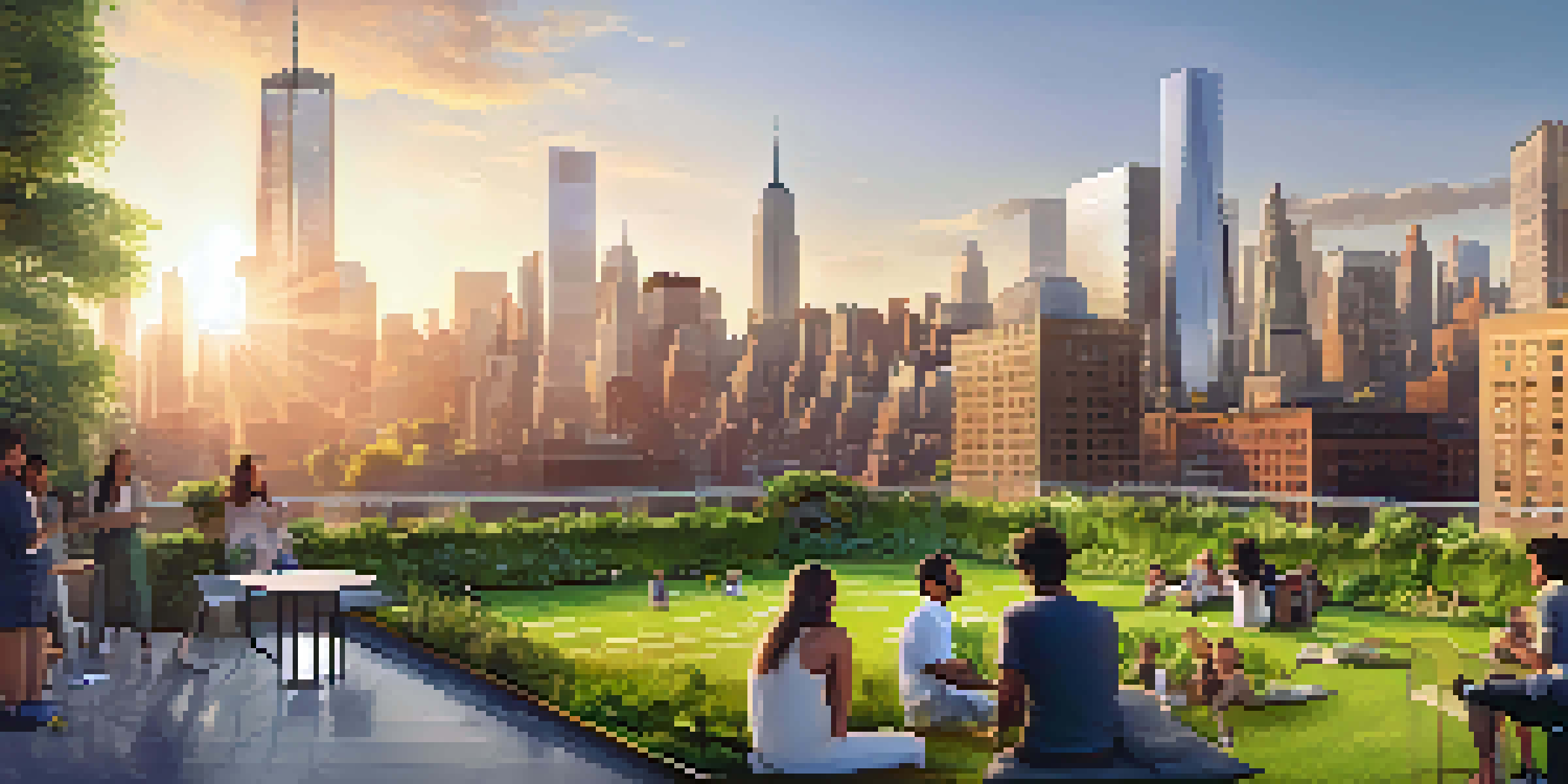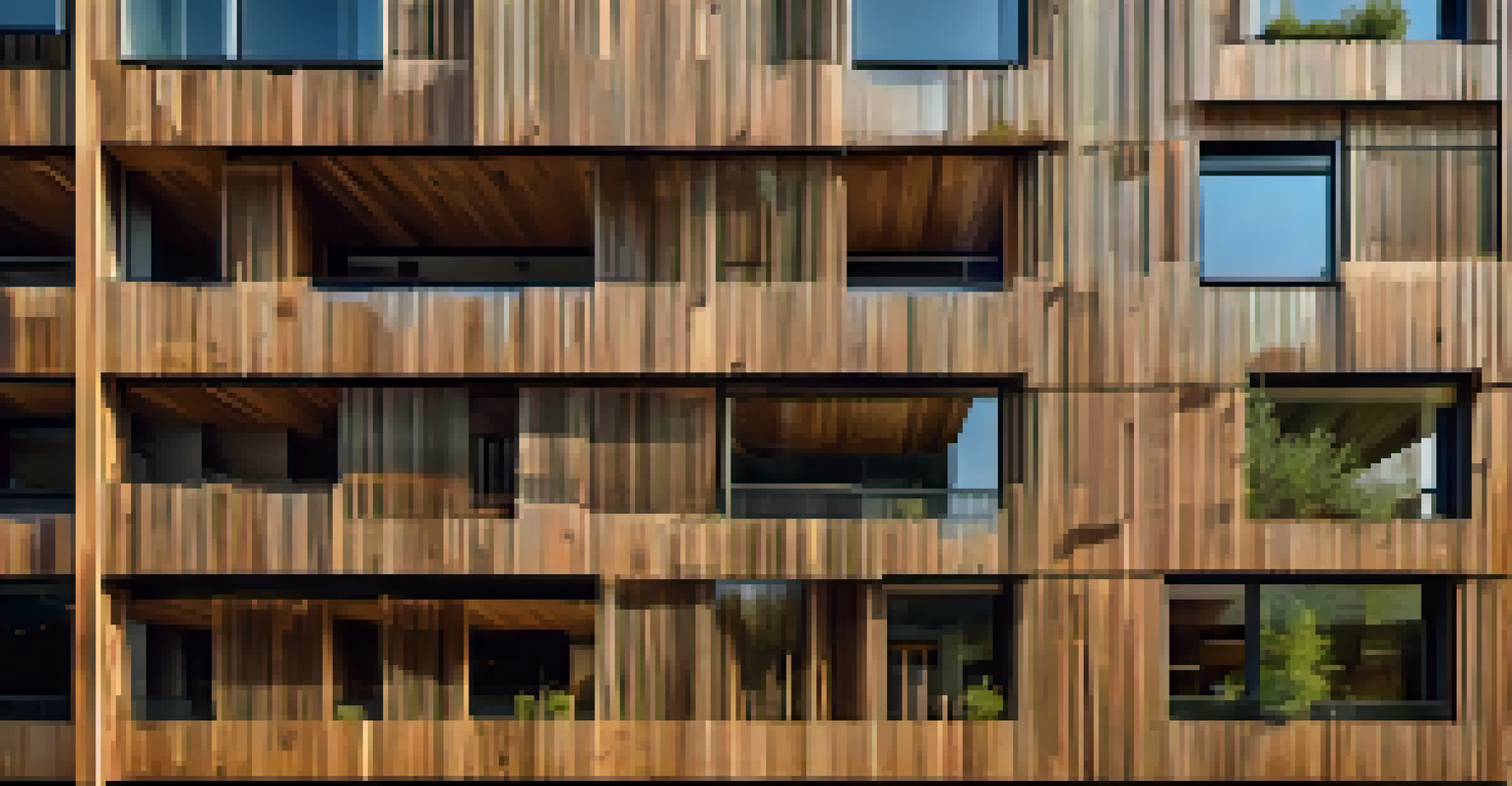The Future of Sustainable Architecture in New York City

The Growing Importance of Sustainable Architecture
Sustainable architecture is becoming a cornerstone for urban planning, especially in dynamic cities like New York. As climate change becomes more pressing, architects and city planners are prioritizing eco-friendly designs that minimize environmental impact. This shift not only addresses ecological concerns but also enhances the quality of life for residents by creating healthier living spaces.
Sustainability is no longer a choice; it is a necessity for our future.
In New York City, where dense populations and limited space present unique challenges, sustainable architecture offers innovative solutions. For instance, green roofs and vertical gardens are not just aesthetic enhancements; they improve air quality, reduce heat, and provide insulation. This approach turns urban spaces into livable ecosystems, benefiting both the environment and the community.
Moreover, as more people prioritize sustainability in their lifestyles, the demand for eco-conscious buildings increases. Developers are recognizing that sustainable architecture not only attracts tenants but can also lead to long-term cost savings through energy efficiency. As a result, the future of New York City’s skyline may include a greater number of green buildings that harmonize with the city’s vibrant urban landscape.
Innovative Building Materials and Techniques
A significant part of sustainable architecture is the use of innovative materials and construction techniques that reduce waste and energy consumption. For example, cross-laminated timber is gaining popularity as a renewable alternative to traditional building materials. This wood product not only lowers carbon emissions but also offers a warm, inviting aesthetic that resonates with city dwellers.

Additionally, advancements in technology, such as 3D printing, are revolutionizing how buildings are constructed. This method can minimize material waste and allow for more complex, customized designs that fit seamlessly into urban environments. Imagine a future where entire sections of a building are printed on-site, drastically reducing transportation emissions and construction timelines.
Sustainable Architecture's Rise
Sustainable architecture is becoming essential for urban planning, enhancing both ecological health and residents' quality of life.
Another exciting development is the incorporation of recycled materials into building design. From reclaimed wood to recycled steel, these materials not only lessen the demand for new resources but also tell a story of sustainability. As architects become more creative with these materials, we can expect to see unique structures that reflect a commitment to eco-friendly practices.
The Role of Green Spaces in Urban Design
Green spaces are crucial in sustainable architecture, especially in a bustling metropolis like New York City. Parks, community gardens, and green roofs not only provide recreational areas but also contribute to biodiversity and urban cooling. They serve as vital lungs for the city, filtering air and reducing the urban heat island effect.
The greatest threat to our planet is the belief that someone else will save it.
Incorporating nature into urban design promotes mental well-being and encourages community interaction. Studies show that access to green spaces can significantly improve residents' quality of life by providing a refuge from the concrete jungle. This connection to nature is essential, especially in high-density environments where outdoor space is limited.
As the city continues to grow, the integration of green spaces into architectural plans will become more critical. Innovative designs, such as vertical parks and rooftop gardens, will likely become standard in new developments. By prioritizing these elements, New York can enhance its urban landscape while fostering a sense of community and environmental responsibility.
Energy Efficiency and Renewable Energy Sources
Energy efficiency is at the heart of sustainable architecture, aiming to create buildings that consume less energy while maintaining comfort. Implementing smart technology, such as automated lighting and heating systems, allows buildings to adapt to the needs of their occupants. This not only reduces energy waste but also lowers utility costs for residents and businesses.
Moreover, the incorporation of renewable energy sources, like solar panels and wind turbines, is becoming more prevalent in architectural designs. These technologies allow buildings to generate their own energy, further decreasing their carbon footprint. Imagine a future where skyscrapers are not just structures but self-sustaining ecosystems that contribute to the city's energy grid.
Community Involvement Matters
Engaging communities in the design process fosters pride and support for sustainable initiatives in urban environments.
As New York City pushes for ambitious sustainability goals, we can expect to see more buildings designed with energy efficiency in mind. Developers who embrace these principles will not only meet regulations but also attract environmentally conscious tenants. This creates a win-win scenario for both the city and its residents, paving the way for a greener future.
Community Involvement in Sustainable Projects
Community involvement is essential in shaping sustainable architecture in New York City. Engaging residents in the design process ensures that new developments meet their needs and reflect local values. This collaborative approach fosters a sense of ownership and pride, making it easier to implement sustainable practices.
Moreover, when communities are actively involved, they are more likely to support and advocate for green initiatives. For instance, neighborhood associations can collaborate with architects to create green spaces that promote biodiversity and enhance local aesthetics. This grassroots involvement not only strengthens community bonds but also leads to more effective and sustainable urban solutions.
As more projects emerge that prioritize community engagement, we can anticipate a shift in how architecture is approached in New York City. This trend may inspire other cities to adopt similar models, promoting sustainability as a collective effort rather than a top-down mandate. Together, communities can create vibrant, sustainable environments that reflect their unique identities.
Challenges Facing Sustainable Architecture
Despite the promising future of sustainable architecture, several challenges remain. One major hurdle is the initial cost of implementing green technologies and materials, which can deter developers from pursuing sustainable options. However, it’s essential to recognize that these investments often lead to long-term savings and environmental benefits.
Additionally, navigating regulatory frameworks and building codes can be complex, especially when integrating innovative designs. Architects and developers must stay informed about changing regulations to ensure compliance while pushing the boundaries of sustainable architecture. This balance between creativity and practicality is crucial for successful implementation.
Innovative Materials Transform Design
The use of innovative building materials and techniques is key to reducing waste and energy consumption in architecture.
Lastly, public perception can also pose challenges. Some individuals may view sustainable buildings as a luxury rather than a necessity, leading to resistance against eco-friendly projects. Educating the public about the benefits of sustainable architecture and its impact on the community is vital to overcoming these barriers and fostering a culture of sustainability.
The Future Outlook for NYC's Sustainable Architecture
Looking ahead, the future of sustainable architecture in New York City appears bright. As awareness of climate change continues to grow, both residents and developers are increasingly prioritizing sustainability in their choices. This shift in mindset is likely to drive innovation and demand for eco-friendly buildings.
Moreover, with the city's ambitious sustainability goals, including reducing greenhouse gas emissions, architects will be challenged to push the envelope further. We can expect to see more groundbreaking projects that redefine what sustainable architecture can achieve, integrating cutting-edge technologies and designs that harmonize with nature.

Ultimately, the future of sustainable architecture in New York City is a collaborative effort. By working together—communities, architects, and developers—we can create a city that not only meets the needs of its residents but also serves as a model for urban sustainability worldwide. The skyline of tomorrow is not just about buildings; it's about building a better future.